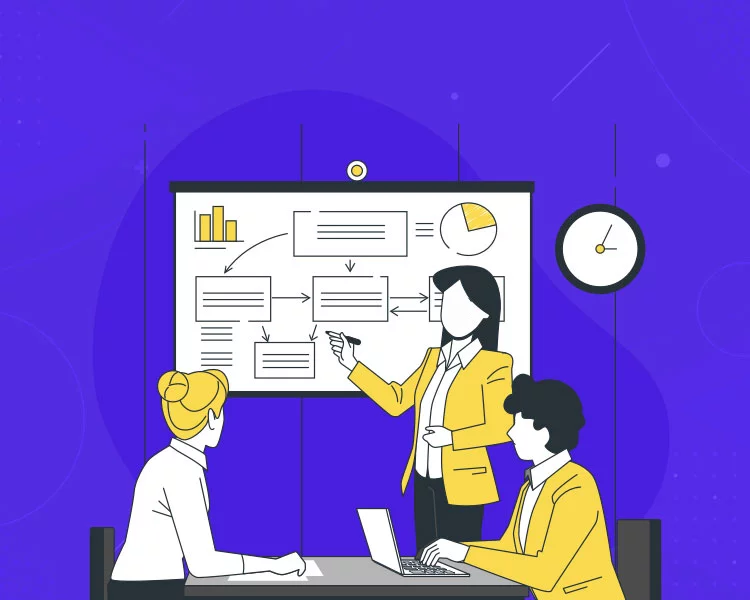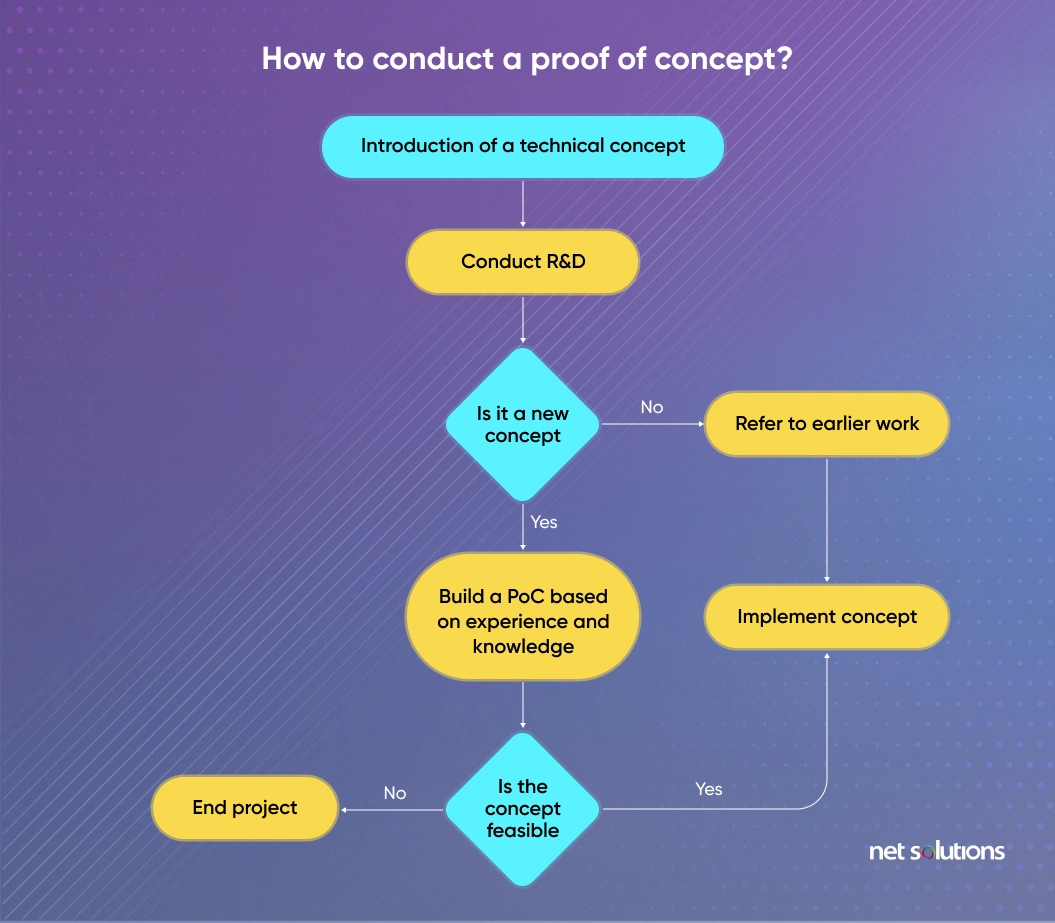Summary: A proof of concept answers whether or not the technology under consideration would fulfill its purpose. However, we must know what to expect to build a successful proof of concept. Read on to learn what a Proof of Concept is, its examples, what a PoC should include, and what we should keep in mind while implementing a PoC on your idea.
In the software development world, where everything is unpredictable, a proof of concept can be an essential tool for predicting, analyzing, and showing your idea’s capabilities.
As an entrepreneur or developer, you may find yourself in situations where you think an existing old software requires changes or your company needs to address its mobile app development strategy.
However, while you are convinced about your idea’s potential, others may not express interest in it or neglect your concept, giving it thought of an unnecessary expense.
Therefore, to make your idea thrive, you must calculate and define its viability and feasibility. You need insights on what you need to implement the concept in terms of technology, finance, infrastructure, etc. You must prove your idea is technically feasible and desirable to company investors and stakeholders.
That’s where you will need proof of concept. Let’s see what it is and how to get it right.

We respect your privacy. Your information is safe.
What is proof of concept?
Before implementing any idea, there is a need for solid and undefiable proof of whether the idea will even work. As a decision-maker, you can’t afford to take unplanned risks.
A PoC or proof of principle fits here as an answer to and answers the big question: whether you can proceed with the hypothesis.
Proof of Concept Definition:
PoC demonstrates a specific idea or method to prove its feasibility. It is a way of testing whether a business idea can be turned into a profitable venture. Depending on the type of business, a PoC can take any form — a video representing the idea described in a document or an early product prototype.
Here are the two results of conducting a PoC:
- Yes, the idea is feasible
- No, the idea is not feasible
If a PoC gives a startup the green signal, you can develop a working model followed by an MVP, which further leads to developing a full-fledged final product.
What should we include in a Proof of Concept?
While creating a proof of concept depends on your business type, there are certain things that your PoC must include. The goal of PoC is not to find the commercial aspects of a business, nor should it describe the complete functionality of a product.
PoC focuses on validating an aspect of software or an idea rather than the whole. It should list essential insights that generate a team’s confidence in a product or identify problems/risks related to its implementation.
Proof of concept in the software development life cycle is essential because:
- A PoC document defines how likely users are to adopt or use the product.
- It helps you identify whether your idea is technically feasible or not.
- It lists technical issues or potential risks (if any) related to implementation and their solutions.
Several types of proof of concept exist in the software development industry. Proof of technology, steel thread, and pilot project are three widely used PoCs to validate ideas and concepts. Here is what they include:
A. Proof of technology
Technical proof of concept aims to check and find any technical issues that may arise during product development. The PoT list and tests numerous features of a product and provides information on whether they are compatible with each other or not. It provides development teams insights on where to start the product development process.
Every risk, problem, and uncertainty that may arise from a technical perspective should be included in the proof of technology.
B. Steel thread
It is a higher level of PoC as it includes almost all of the product’s properties, not just the technology. It analyzes aspects like design, software architecture, and profitability of an idea or product.
Steel thread is basically like creating a prototype that seeks to be as minimal as possible—for example, implementing a few UI screens of an app or website as a steel thread.
C. Pilot project
You can consider this type of PoC as a beta version of your product. A pilot project is very similar to a minimum viable product, and businesses can even put it to the test to gather feedback. Along with users and stakeholders, it can also help you collect feedback from investors.
A proof of concept helps open your eyes to any potential problems — it can also help you generate funding for product development. If you have a PoC, you shouldn’t hesitate to reach out to potential investors and pitch your idea.
Now that you know what must be included in a proof of concept coming up, next is a real-world example of how PoCs can help validate hypotheses.
A real-life proof of concept example
A big player like Walmart, one of the leading American retail MNCs, implemented two “Proof of concepts” (PoCs) at their end.
Walmart supposed blockchain technology to be a good resolution for its decentralized food supply ecosystem. They created a food traceability system based on Hyperledger Fabric to validate the hypothesis.
They partnered with IBM to test the practicality of blockchain technology in building a food traceability system. One PoC revolved around tracing mangoes around Walmart’s US stores, while the other revolved around tracing pork sold in China. Both the PoCs worked!
With the go-ahead from IBM, the retail giant traced the origin of over 25 products from around five different suppliers using the technology — a fantastic example of proof of concept.
Without proof of concept, Walmart would have been still pondering whether to invest in blockchain technology, leaving it in a high-risk situation either way.
How to create a successful proof of concept?
A successful proof of concept (PoC) precedes the real-life implementation of an idea. A Proof of Concept aims to determine an idea’s feasibility, and it is not a good business decision to overlook or skip it, especially when the stakes are high.
Here is an illustration of the entire flow of the process followed by PoC.
Here is a step-by-step process you should follow when trying to create a proof of concept (POC) for any software project:
Step 1: Conduct research and development
When you write a proof of concept, the first thing that comes into mind is R&D (Research and Development). The tech team must conduct extensive research on the history of similar work done or in progress across the globe.
If there is none, the next step should be to analyze existing guides, PDFs, scholarly articles, or even tutorials that would act as a key point of reference for the team.
If it is not readily available, consider your idea novel; if it falls in place, it can mark you as a leading pioneer!
However, proving the technical feasibility of a stand-alone project does not have a “How-to” reference.
So, the development team is left with three things:
- The instinct that comes with experience
- Skills that are driven by knowledge
- Curiosity to try something new
Thus, combining the art of technology and the development team’s understanding, a unique path of a PoC is reasonably achievable.
It may take time to build a PoC. It may sometimes seem infeasible. But challenging the team’s technical abilities is the key here. Setting your standards can call for success when a business is still developing.
Step 2: Specify the need for your idea
Once you are done with research around your idea, it is time to specify who needs it and why. Consider listing user personas your product will target and their pain points to better understand your idea’s needs.
However, don’t just assume things here. As you collect evidence at this stage of your project needs, interview your potential users and ask them questions regarding what they desire and need to solve their problems. Consider conducting in-depth interviews or online surveys to make your proof of concept look more authentic.
Find out your users’ frustrations and list their inconveniences to have an idea of the user experience they expect from the product. Doing so will help you know your users better, and you might consider making amendments to your idea after getting these insights.
For a detailed guide on how you can know your product potential better, here is an ultimate guide to Product Discovery.
Step 3: Check your idea’s feasibility
To successfully run a proof of concept, you must ensure your idea is technically feasible.
Along with finding the suitable tech stack needed to implement your idea, you also have to find out the answers to the following questions while checking the feasibility:
- How difficult is it to implement your idea?
- What third-party tools will you need for implementation?
- What is going to be the cost of implementation?
- What about the scalability of the product?
- Can you grow your product to generate profits?
- What are the risks involved in implementation?
You can look for any proof of concept template online or craft it yourself to present the collected answers to your investors and other company stakeholders. Once all sounds good, you should look for technical alternatives available to implement the solution.
Your end goal should be to minimize the cost of implementation and the risk involved. It is an excellent approach to collect all the options and do weighted scoring to find the best.
For example, suppose you are planning to improvise the payment feature of your taxi booking app. You have several non-validated ideas and don’t want to spend all your resources testing them. Find out the ways to implement them technically:
- Solution 1: You can automatically split the payment between your app and the driver when a customer pays for his ride.
- Solution 2: You can make it a two-way process by accepting all the customers’ payments and initiating different drivers’ payments every day or week.
Both solutions are feasible, but the technical implementation will differ. Find out which solution will cost you less and is easy to implement technically. This way, you will not just check your idea’s feasibility but find the perfect solution to implement it.
PoC implementation: Key expectations vs. reality
While creating a POC, a good understanding of the expectations vs. reality will keep the business makers informed and help them make intelligent decisions before draining all the time and money.
1. PoCs don’t always follow the plan
Turning theoretically existing concepts into practically feasible ventures is the purpose behind building any proof of concept. Although the experts might have plans to prove practical feasibility, they may sometimes need to catch up.
You should understand that proof of concept follows a try-and-test trajectory that cannot rely on a consistent path across the process flow.
It is similar to a “Snakes and Ladder” journey, which sometimes takes the team up the ladder and makes a fall.
It is essential to give weight to inner instincts, i.e., it is time to make a data-informed decision.
And, if you are wondering what might cause the snake to bite your progress (metaphorically speaking), the answer narrows down to the selected technical solution simply failing to produce the desired result, technical inefficiencies of the team, financial limitations of the budding startup, or the team not meeting the set deadlines.
Another reason that might hamper PoC development could be a problem with patents. The path to a solution may lead your team through a minefield of patented solutions you would have to license or work around.
Key takeaway: Accept what comes your way and be ready with a Plan B when Plan A seems off track. Having a broad perspective should be the more extensive agenda of the team. Refrain from sticking to traditional software methodologies, as the possibilities introduced by technology are infinite.
2. Proof of concept is not an MVP or Prototype
The most common misconception that has been doing the rounds in the tech world is that people think PoC is the same as the MVP and Prototype. But here’s the truth:
Proof of Concept (PoC) ≠ a Minimal Viable Product (MVP)
PoC (proof of concept) exists to check the feasibility of bringing a technological idea into reality before the startup spends its resources in its building phase. It mitigates risks associated with trying something for the first time.
On the other hand, an MVP (Minimal Viable Product) is a tiny or basic version of the actual product that exists for market validation.
As and when potential user personas are exposed to MVPs, refinements to the product are made based on user feedback and reviews.
In short, PoCs exist to convince the stakeholders, project managers, and investors whether the idea the startup is working on is worth trying.
It is more of a surety that any business entrepreneur would require before spending too much on a concept’s full-scale production.
And, MVPs contrarily are tried and tested ideas launched in the market with the intent of getting better with time.
User personas interact with the MVP, who provides feedback based on experienced digital customer journeys.
Here’s a summarized table that lists the differences between PoCs and MVPs.
Key takeaway: There is nothing like PoC vs. prototype vs. MVP — these are different terms, and comparing them is not a good idea. Do not believe what others say or preach. Deploy the team to research what a PoC is all about before moving further. Also, conducting meetings to explain your agenda behind the PoC development process is a good idea.
3. Proof of concept is everyone’s job
Everybody is entitled to their opinion, which is a good thing. At least your startup gives everyone a platform to have one.
The truth is that everybody has a different perception and interpretation of the proof of concept.
Be it prime decision-makers, the IT head, the development team, or the principal stakeholders, they all take PoC differently.
So, respect each of the parties involved to achieve a common understanding of the goal.
Bringing everybody on the same page is highly crucial, which starts with:
- Defining success and acceptance criteria for the PoC
- Sticking to technical “to-Do’s” over UX design requirements
- Aligning expectations that are subject to mutual interests and decisions
- Having a communication model that works towards keeping everyone informed and updated
- Close collaboration among key people involved so that the PoC does not fall short on loose information
- Having a pre-set timeline for building a PoC and sticking to it as much as possible
Key takeaway: Build the foundation of the PoC based on three areas, i.e., communication, collaboration, and timeline. Let the critical people involved in building a PoC have a say in what they expect out of the PoC. Do not leave anyone behind just with the intent of rushing things.
4. Your tech partner may get it wrong
PoCs can be hard to get through, especially when the concept is entirely new in the market.
Hiring a tech partner is the right choice owing to the knowledge and experience involved in their case.
Nothing could be better if they prove that the technical concept stands a chance to witness the dawn.
On the contrary, you can also hear a “NO” from the tech head honchos.
Does that mean you need to give up and agree to their words?
You should take that with a grain of salt till you see the proof & data behind the denial.
Challenge the tech partners, have some additional documented proof that you can rely on, or when your gut feeling tries to convey a different story, feel free to consult and even engage a different third-party expert to validate because tech partners can be wrong too!
Here are the five mistakes you should avoid when working with tech partners:
However, that nowhere means the startup stays stuck upon an idea with no practical perspective. If you challenge the PoC feasibility, know when to stop.
Because if you don’t, the startup will be wasting resources and time, thus stagnating the business endeavor’s overall growth.
Key Takeaway: Ask for undefiable proof that negates the possibility of the concept. If you decide to take your course, talk to the experts about your doubts and related queries. Going the extra mile could be your best bet if you strongly believe in something.
Frequently Asked Questions
-
01
How do you evaluate proof of concept?
We can evaluate whether a proof of concept is successful or not based on the following criteria:- The PoC meets the measures of success and the requirements of stakeholders
- You have identified the resources and the skills you need
- You have defined the process approach and the prototype scope
- You have identified and prioritized the high-level business and technical features
-
02
What should I do after POC?
Once your PoC is booming, and the stakeholders have accepted it, developing the prototype and the minimum viable product should be the next step. -
03
How long does it take to make a proof of concept?
You can create a proof of concept in a 3-4 week sprint. However, it may take around 12 months to move your idea from PoC to prototype.
-
04
Can a PoC fail?
A PoC can fail. Around 50% of PoCs fail due to undefined scope, vague understanding of business requirements, and lack of collaboration. However, an unsuccessful PoC doesn’t mean a death sentence. Even if the PoC fails, you can learn what doesn’t work in the market and tweak it to better suit your target audience’s needs.


 Updated: November 18, 2022
Updated: November 18, 2022











